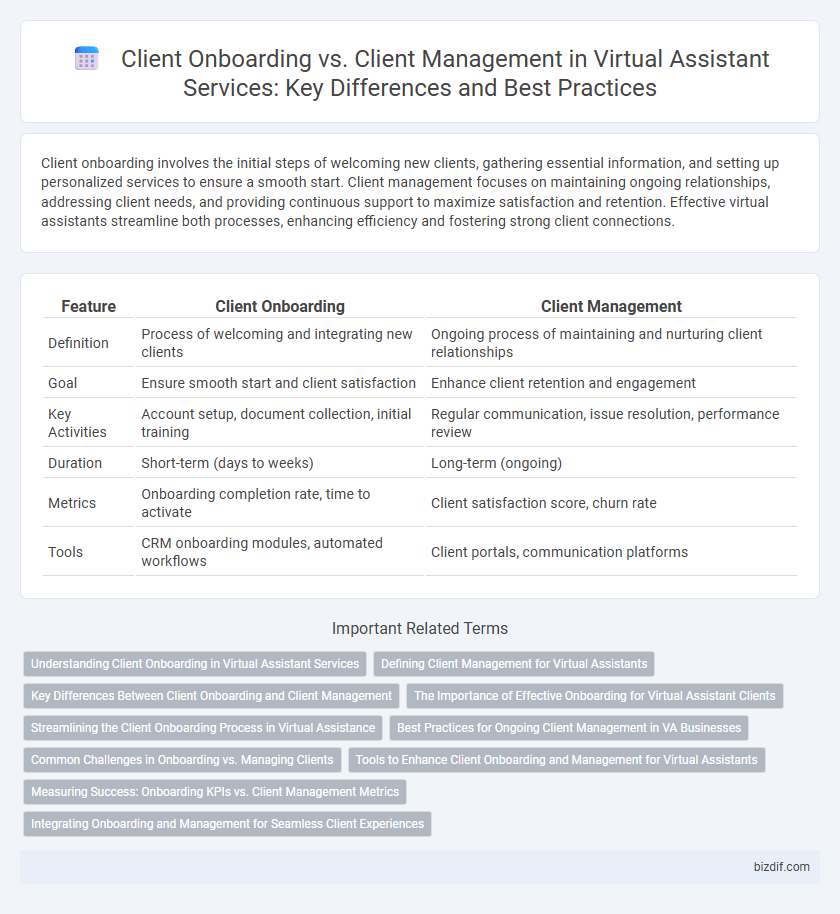Client onboarding involves the initial steps of welcoming new clients, gathering essential information, and setting up personalized services to ensure a smooth start. Client management focuses on maintaining ongoing relationships, addressing client needs, and providing continuous support to maximize satisfaction and retention. Effective virtual assistants streamline both processes, enhancing efficiency and fostering strong client connections.
Table of Comparison
| Feature | Client Onboarding | Client Management |
|---|---|---|
| Definition | Process of welcoming and integrating new clients | Ongoing process of maintaining and nurturing client relationships |
| Goal | Ensure smooth start and client satisfaction | Enhance client retention and engagement |
| Key Activities | Account setup, document collection, initial training | Regular communication, issue resolution, performance review |
| Duration | Short-term (days to weeks) | Long-term (ongoing) |
| Metrics | Onboarding completion rate, time to activate | Client satisfaction score, churn rate |
| Tools | CRM onboarding modules, automated workflows | Client portals, communication platforms |
Understanding Client Onboarding in Virtual Assistant Services
Client onboarding in virtual assistant services involves systematically gathering essential client information, setting clear expectations, and establishing communication protocols to ensure a smooth start. This process enhances client satisfaction and reduces misunderstandings by aligning virtual assistant tasks with specific client needs from the outset. Effective onboarding lays a strong foundation that streamlines ongoing client management, improving service delivery and long-term engagement.
Defining Client Management for Virtual Assistants
Client management for virtual assistants involves maintaining continuous communication, organizing client information, and ensuring timely delivery of services to enhance client satisfaction and retention. This process includes tracking project progress, addressing client inquiries, and adapting services to meet evolving client needs, which strengthens long-term professional relationships. Effective client management tools such as CRM software and task management platforms are essential for virtual assistants to streamline workflows and optimize client interactions.
Key Differences Between Client Onboarding and Client Management
Client onboarding involves the initial steps of welcoming and integrating a new client through account setup, documentation, and establishing communication channels, ensuring a smooth start to the relationship. Client management focuses on maintaining and nurturing ongoing client relationships by handling support requests, tracking progress, and delivering personalized services to enhance satisfaction and retention. Key differences include onboarding's emphasis on first impressions and compliance, while management prioritizes long-term engagement and problem resolution.
The Importance of Effective Onboarding for Virtual Assistant Clients
Effective onboarding sets the foundation for successful client management by establishing clear communication channels, expectations, and workflows from the start. Virtual assistants who prioritize detailed onboarding reduce misunderstandings and increase client satisfaction by delivering tailored services aligned with client goals. Streamlined onboarding processes also accelerate productivity, enabling virtual assistants to manage multiple clients efficiently while maintaining high-quality support.
Streamlining the Client Onboarding Process in Virtual Assistance
Streamlining the client onboarding process in virtual assistance enhances efficiency by automating document collection, appointment scheduling, and initial communication through specialized software. Integrating CRM systems tailored for virtual assistants ensures seamless data transfer between onboarding and ongoing client management, reducing redundancy and improving client experience. Clear onboarding protocols and customized workflows enable faster engagement and establish a solid foundation for long-term client relationships.
Best Practices for Ongoing Client Management in VA Businesses
Effective client onboarding establishes clear expectations, gathers comprehensive information, and sets communication protocols to streamline ongoing interactions. Best practices for ongoing client management in virtual assistant businesses include regular performance reviews, proactive problem solving, and maintaining consistent, personalized communication to foster trust and client satisfaction. Leveraging project management tools and CRM systems enhances task tracking, deadline adherence, and client feedback integration for sustained partnership success.
Common Challenges in Onboarding vs. Managing Clients
Client onboarding often faces challenges such as gathering accurate client information, setting clear expectations, and integrating new clients into existing systems smoothly. In contrast, client management struggles with maintaining consistent communication, addressing evolving client needs promptly, and ensuring ongoing satisfaction and retention. Both phases require tailored strategies to handle data accuracy, relationship building, and efficient workflow to optimize client experience and business outcomes.
Tools to Enhance Client Onboarding and Management for Virtual Assistants
Effective client onboarding and management for virtual assistants is streamlined through specialized tools such as CRM platforms like HubSpot and Zoho, which facilitate organized client data and communication. Project management applications like Trello and Asana enhance task tracking and collaboration, ensuring seamless workflow from onboarding to ongoing client interactions. Automated scheduling tools such as Calendly optimize appointment coordination, contributing to a professional and efficient client experience.
Measuring Success: Onboarding KPIs vs. Client Management Metrics
Measuring success in client onboarding involves tracking KPIs such as time-to-first-value, client activation rate, and onboarding completion rate to ensure smooth and timely integration. Client management metrics focus on long-term indicators like customer satisfaction score (CSAT), Net Promoter Score (NPS), retention rate, and lifetime value (LTV) to gauge ongoing relationship health and profitability. Comparing onboarding KPIs with client management metrics highlights the transition from initial engagement to sustained customer success and growth.
Integrating Onboarding and Management for Seamless Client Experiences
Integrating client onboarding and client management streamlines communication and data flow, enhancing overall client satisfaction and retention. A unified virtual assistant platform automates key tasks such as document collection, contract signing, and follow-up reminders, reducing manual errors and accelerating the onboarding process. Continuous monitoring and personalized service during client management ensure proactive problem-solving and stronger long-term relationships.
Client onboarding vs Client management Infographic

 bizdif.com
bizdif.com